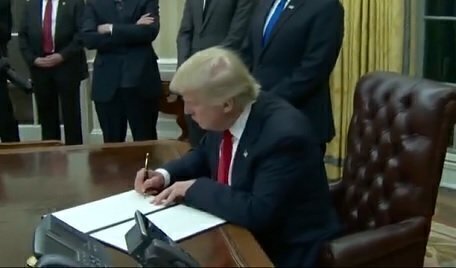Wouldnt It Be Easy to Figure Out Who is Disobeyying Trumps Orders
One of the first "orders" of business for President Donald Trump was signing an executive order to weaken Obamacare, while Republicans figure out how to replace it. So what powers do executive orders have?
 An executive order is a directive from the President that has much of the same power as a federal law. Several landmark moments in American history came about directly from the use of executive orders issued from the White House's desk, including one Supreme Court decision that limited a presidential executive order issued by Harry Truman.
An executive order is a directive from the President that has much of the same power as a federal law. Several landmark moments in American history came about directly from the use of executive orders issued from the White House's desk, including one Supreme Court decision that limited a presidential executive order issued by Harry Truman.
In President Trump's case, his executive order on Obamacare allows federal agencies to "take all actions consistent with law to minimize the unwarranted economic and regulatory burdens of the [Affordable Care] act, and prepare to afford the states more flexibility and control to create a more free and open health care market."
The constitutional basis for the executive order is the President's broad power to issue executive directives. According to the Congressional Research Service, there is no direct "definition of executive orders, presidential memoranda, and proclamations in the U.S. Constitution, there is, likewise, no specific provision authorizing their issuance."
But Article II of the U.S. Constitution vests executive powers in the President, makes him the commander in chief, and requires that the President "shall take Care that the Laws be faithfully executed." Laws can also give additional powers to the President.
While an executive order can have the same effect as a federal law under certain circumstances, Congress can pass a new law to override an executive order, subject to a presidential veto.
Every President since George Washington has used the executive order power in various ways. Washington's first orders were for executive departments to prepare reports for his inspection, and a proclamation about the Thanksgiving holiday. After Washington, other Presidents made significant decisions via executive orders and presidential proclamations.
President Abraham Lincoln suspended the writ of habeas corpus during the Civil War using executive orders in 1861. Lincoln cited his powers under the Constitution's Suspension Clause, which states, "the privilege of the writ of habeas corpus shall not be suspended, unless when in cases of rebellion and invasion the public safety may require it."
Supreme Court Chief Justice Roger Taney, in his role as a federal circuit judge, ruled that Lincoln's executive order was unconstitutional in a decision calledEx Parte Merryman. Lincoln and the Union army ignored Taney, and Congress didn't contest Lincoln's habeas corpus decisions.
Two other executive orders comprised Lincoln's Emancipation Proclamation. Lincoln was fearful that the Emancipation Proclamation would be overturned by Congress or the courts after the war's end, since he justified the proclamation under his wartime powers. The ratification of the 13th Amendment ended that potential controversy.
President Franklin Roosevelt established internment camps during World War II using Executive Order 9066. Roosevelt also used an executive order to create the Works Progress Administration.
And President Harry Truman mandated equal treatment of all members of the armed forces through executive orders. However, Truman also saw one of his key executive orders invalidated by the Supreme Court in 1952, in a watershed moment for the Court that saw it define presidential powers in relation to Congress.
The Court ruled inYoungstown Sheet and Tube Co. v. Sawyer that an executive order putting steel mills during the Korean War under federal control during a strike was invalid. "The President's power to see that the laws are faithfully executed refutes the idea that he is to be a lawmaker," Justice Hugo Black said in his majority opinion.
It was Justice Robert Jackson's concurring opinion that stated a three-part test of presidential powers that has since been used in arguments involving the executive's overreach of powers.
Jackson said the President's powers were at their height when he had the direct or implied authorization from Congress to act; at their middle ground – the Zone of Twilight, as he put it, when it was unsure which branch could act; and at their "lowest ebb" when a President acted against the expressed wishes of Congress.
The use of executive orders also played a key role in the Civil Rights movement. In 1957, President Dwight Eisenhower used an executive order to put the Arkansas National Guard under federal control and to enforce desegregation in Little Rock. Affirmative action and equal employment opportunity actions were also taken by Presidents Kennedy and Johnson using executive orders.
President Roosevelt issued the most executive orders, according to records at the National Archives. He issued 3,728 orders between 1933 and 1945, as the country dealt with the Great Depression and World War II.
President Truman issued a robust 896 executive orders over almost eight years in office. President Barack Obama issued 277 orders during his presidency. His predecessor, President George W. Bush, issued 291 orders over eight years, while President Bill Clinton had 364 executive orders during his two terms in office.
The most-active President in the post-World War II era, in terms of executive orders, was Jimmy Carter, who averaged 80 orders per year during his four-year term.
aguinaldoagam1998.blogspot.com
Source: https://constitutioncenter.org/blog/executive-orders-101-what-are-they-and-how-do-presidents-use-them
0 Response to "Wouldnt It Be Easy to Figure Out Who is Disobeyying Trumps Orders"
Post a Comment